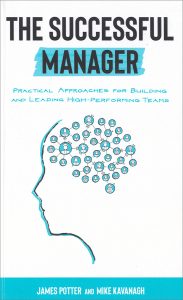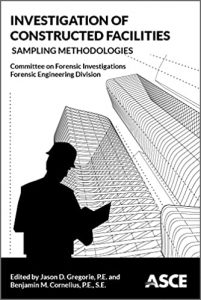Facility officers have a tough job. They must manage people and places and they also must manage problems and find solutions. The two books reviewed here address managing people and finding solutions to difficult facility problems in a logical and defensible way.
THE SUCCESSFUL MANAGER: PRACTICAL APPROACHES FOR BUILDING AND LEADING HIGH-PERFORMING TEAMS
James Potter and Mike Kavanagh, Potter Consulting LLC, 2020, 201 pp., softcover ($18.99).
There are hundreds of books on leadership and management. Many are written by international experts or consultants who are professors at top business schools. But finding a well-written book by an actual manager that is really about managing, with some leadership techniques interwoven, is difficult. It’s likely those books haven’t been written because the potential writer is so busy managing that there’s no time to write one. Fortunately, that’s not the case with The Successful Manager by James Potter and Mike Kavanagh.
 The Successful Manager is written with the busy manager in mind. It combines important management techniques and steps together with some important leadership skills, so a busy manager can jump to the appropriate section or chapter and get solid recommendations and ideas about how to deal with a problem at hand.
The Successful Manager is written with the busy manager in mind. It combines important management techniques and steps together with some important leadership skills, so a busy manager can jump to the appropriate section or chapter and get solid recommendations and ideas about how to deal with a problem at hand.
The book is organized in 14 chapters, most with clear and focused titles so the reader can use it when a particular problem arises and assistance is needed. That doesn’t mean the book is a crutch for one’s daily problems; it’s really well written and can be used as an overall management tool to be read from beginning to end, and then applied as the situation warrants.
What I liked about the book was its relatively casual approach. Figures appear hand drawn, just as if the author was trying to explain an approach or technique in front of the reader. There are several descriptions of standard management techniques, ones that you’ll see in any APPA supervisor or leadership program. They are described clearly, with examples provided of right and wrong ways to apply the technique. Sadly, there are too many people who read about a technique but don’t apply it in the right way and don’t get the results they seek; this book helps avoid that problem.
The Successful Manager is a helpful resource for a person who has a clear career path in mind as well as someone who may have risen to a new leadership position and just needs help dealing with the daily management issues of balancing what they have decided with the need to bring the troops along. It also provides good recommendations on evaluating individual team members and giving them sufficient direction for improvements without becoming a micromanager.
If you’re in the market for a good management book, The Successful Manager will address your needs. It’s clear, concise, and an excellent go-to reference.
INVESTIGATION OF CONSTRUCTED FACILITIES: SAMPLING METHODOLOGIES
Jason D. Gregorie and Benjamin M. Cornelius, editors, American Society of Civil Engineers (ASCE) Committee on Forensic Investigations, 2021, Reston, VA, 74 pp., softcover or e-book (pdf) ($58.95 ASCE member; $75 nonmember).
Facility managers frequently assume responsibility for a facility well after construction and initial use. They also assume responsibility for any problems arising from its design, construction, or usage. While one would like to think that all problems are easily resolved by standard procedures or by hiring a consultant, it is sometimes necessary to do some additional investigation to identify the root cause of a problem and then apply a logical solution.
 While Investigation of Constructed Facilities is focused more on those engineering professionals who perform forensic evaluations that frequently stem from a structural failure, the sampling methodologies outlined in the book have relevance for facility managers as well. The facility officer may decide to tackle a relatively minor investigation to plan a meaningful and permanent correction to a nagging problem. The process described can guide the investigation and help identify the problem.
While Investigation of Constructed Facilities is focused more on those engineering professionals who perform forensic evaluations that frequently stem from a structural failure, the sampling methodologies outlined in the book have relevance for facility managers as well. The facility officer may decide to tackle a relatively minor investigation to plan a meaningful and permanent correction to a nagging problem. The process described can guide the investigation and help identify the problem.
The more likely approach will be to hire a professional, particularly if the problem is significant and may lead to legal action. In this case, the facility officer can use Investigation of Constructed Facilities to develop an initial approach with which to engage a professional; modifications to the approach may be made in subsequent consultations once the professional is engaged. Using this guide will make the facility officer a better-informed client and can improve understandings between the facility officer and consultant—for instance, should random samples or directed samples be used to identify any problems. When samples are obtained, the book can show you how the sample results can be verified.
The guide provides a well-organized, eight-step methodology to initiate and manage a forensic investigation with clear information on what occurs at each step. A number of material standards are provided in the appendix. The standards are by no means complete for every facility but provide a starting point; a professional can identify additional standards that should be considered for specific facility problems.
While Investigation of Constructed Facilities is focused on civil/structural issues, it provides sufficient examples to undertake analogous investigations for mechanical and electrical problems. The guideline can be a useful addition for a large facility organization faced with difficult and interrelated facilities problems.
Ted Weidner is professor of engineering practice at Purdue University, West Lafayette, IN, and consults on facilities management issues primarily for educational organizations. He can be reached at [email protected]. If you would like to write a book review, please contact Ted directly.
Bookshelf
Book reviews on current publications relevant to the profession, trends, and working environment of facilities and educational managers and professionals. To contribute a book review, contact Ted Weidner, field editor of this column.
See all Bookshelves.


